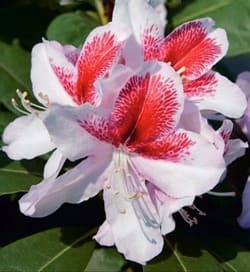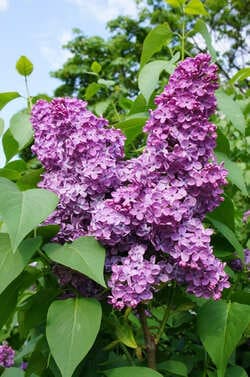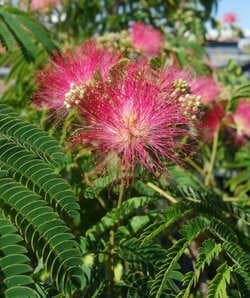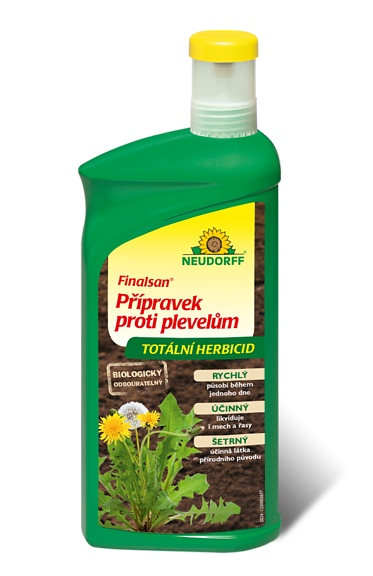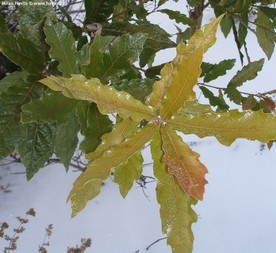We all have a drug. Some are illegal, some are borderline illegal, and many are perfectly harmless, except they give you a backache and ruin the ladies' nails. It's called "gardening". Have I ever mentioned the inane joke in the name of this hobby? Just look it up: GARDEN-THINKING. Is this some kind of Canadian joke that the old Czech linguists made up on us? We don't destroy gardens, we beautify them!!! (At least we think so...)
.jpg) And because I am a man, my greatest passion is not to create a beautiful garden and lie down in a hammock with a beer (I am not Homer Simpson), but to continue creating. For me, my greatest passion is to find new and new plants not only for my garden, but for the gardens of our climate. The first group of such plants are novelties that someone has already tried in our climate or, given the parentage of these new and generally beautiful creations, it is obvious that they will grow here without any problem. I, however, am much more inclined to try plants that few have thought of planting in our country. And believe me, when they do, and the plants not only survive but are very willing to take on the world, I am happier than a flea. By the way, do any of you know how to tell if fleas are happy?
And because I am a man, my greatest passion is not to create a beautiful garden and lie down in a hammock with a beer (I am not Homer Simpson), but to continue creating. For me, my greatest passion is to find new and new plants not only for my garden, but for the gardens of our climate. The first group of such plants are novelties that someone has already tried in our climate or, given the parentage of these new and generally beautiful creations, it is obvious that they will grow here without any problem. I, however, am much more inclined to try plants that few have thought of planting in our country. And believe me, when they do, and the plants not only survive but are very willing to take on the world, I am happier than a flea. By the way, do any of you know how to tell if fleas are happy?
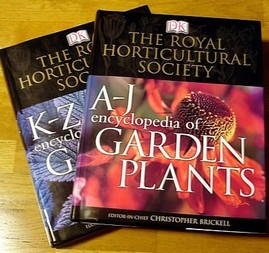 In this country, plant testing needs to focus mainly on frost resistance as the temperature zone of the country is already below -15°C, the UK's limiting temperature. Why is that? Because it is the UK's passion for gardening that is years old and has already produced many results and information that the rest of Europe can only dream of. England's Royal Horticultural Society (RHS) has produced a number of publications including the best-selling gardening bible, The RHS Encyclopedia of Garden Plants. I was delighted to discover that it was successfully published in English a few years ago. So if the RHS, like most of the rest of Europe, where plants have also been around for many years, such as France, the Benelux countries and Italy, describes a plant as fully hardy, it is a hardiness to -15°C. It is up to us to test it in our winters, when the temperature can drop to -24°C. Quite a difference, don't you think? Other factors that are important for testing plants are the amount of rainfall, the length of the growing season and the type and quality of the soil, especially its permeability. It may look pretty scientific, but don't worry, we're getting down to the more interesting details - the practicalities.
In this country, plant testing needs to focus mainly on frost resistance as the temperature zone of the country is already below -15°C, the UK's limiting temperature. Why is that? Because it is the UK's passion for gardening that is years old and has already produced many results and information that the rest of Europe can only dream of. England's Royal Horticultural Society (RHS) has produced a number of publications including the best-selling gardening bible, The RHS Encyclopedia of Garden Plants. I was delighted to discover that it was successfully published in English a few years ago. So if the RHS, like most of the rest of Europe, where plants have also been around for many years, such as France, the Benelux countries and Italy, describes a plant as fully hardy, it is a hardiness to -15°C. It is up to us to test it in our winters, when the temperature can drop to -24°C. Quite a difference, don't you think? Other factors that are important for testing plants are the amount of rainfall, the length of the growing season and the type and quality of the soil, especially its permeability. It may look pretty scientific, but don't worry, we're getting down to the more interesting details - the practicalities.
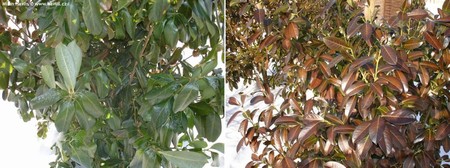 I don't want to bore you with the details of each test, but rather with their results or interesting facts. I offer here plants that have already been tested in my garden and in other places under my supervision and I can responsibly say what the result was. Even if the result has sometimes been negative, the test has been useful, because by doing so I can say to those of you who are doing similar work that it is no longer necessary to worry about it. Are you ready? Here we go!
I don't want to bore you with the details of each test, but rather with their results or interesting facts. I offer here plants that have already been tested in my garden and in other places under my supervision and I can responsibly say what the result was. Even if the result has sometimes been negative, the test has been useful, because by doing so I can say to those of you who are doing similar work that it is no longer necessary to worry about it. Are you ready? Here we go!
.jpg) Magnolia grandiflora 'Francois Tréyve' (Treyviensis)
Magnolia grandiflora 'Francois Tréyve' (Treyviensis)
The first big sensation, and the reason I started gardening in the first place, is the magnolia grandiflora or magnolia grandiflora and some of its cultivars. I have written a whole article about it here, so I will now concentrate only on the latest novelty, which I am now testing, and which has already had the worst of it and is just waiting for the last test, which is resistance to the Bohemian winter sun. Today is 26.12.2010, we have had 2 nights of -14°C followed by full sun during the day and one night of -11°C followed by bright sunshine until about 14.30 hours and the plant resists excellently. Not a single sign of burning. While 'Gallissoniére' has already browned its young, immature leaves. This variety is called 'Francois Treyve' and was tested 140 years ago in the severe winters of 1870 and 1880. Why did it take so long to get into commercial cultivation? I don't know, but it's a shame. It has a rather pyramidal growth habit, not spreading out to the sides like the others, so it can fit into a smaller garden. The leaves are more rounded, very interesting, the creamy white flowers are medium sized and again strongly scented like all the other varieties.
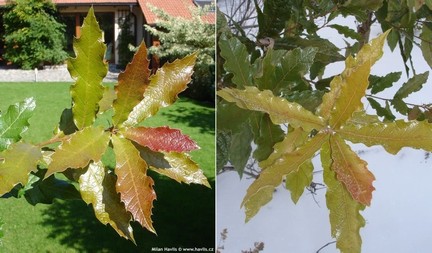 Quercus rhysophylla 'Maya'
Quercus rhysophylla 'Maya'
Mexican oak in Czech, in England it is called 'curly-leaved' after the curly-leaved oak - eriobotrya japonica. Loquat is a beautiful evergreen deciduous tree, but it doesn't stand a chance here. I've tried it and at -15°C the leaves and soft shoots have died. Fortunately, there is a new variety of Mexican oak on the market called Maya, which is not only prettier, but also has a little more hardiness. The leaves are very unlike oak, but instead resemble loquat, being glossy and smooth on top and rough underneath, very firm and quite large. In addition, the new growth is a striking bronze red to amber orange. The plant is so new that there is only information about sale sizes on the web, but few offer growing experience. And yet. I found a German grower's site some time ago who described it as a sensational novelty suitable for their climate, having survived their winter without any difficulty. And there is something to be said for that, for the German winters, though not so hard as ours, have a long, warmer autumn, in which the evergreen plant is able to make new shoots, which freeze at the first hard frosts. This did not happen and so I decided to try it here. So far it has done great, even in full winter sun and temperatures of -14°C the leaves show not the slightest sign of damage. If the test is confirmed this winter 2010/2011, you can look forward to seeing it on sale in the spring.
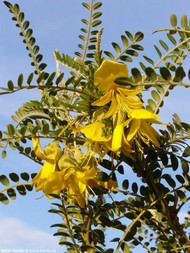 Sophora microphylla 'Sun King'
Sophora microphylla 'Sun King'
With this small-leaved cranesbill, I really wanted it to make it through the winter, because something amazing would have happened - we would have had the first evergreen plant with trailing leaves. But, as you can guess, the experiment failed. And not only in my garden in southern Bohemia, but also in Prague, where the temperature is always milder, and unfortunately not even in Boleslav, where the subsoil is very permeable to sandy, so it is obvious that the death was not due to poor planting, but simply to the lack of hardiness of the plant. It is a pity, but perhaps in the future another adept will be found.
Osmanthus
- Osmanthus heterophyllus 'Goshiki' (Tricolor)
- Osmanthus x fortunei
- Osmanthus armatus
- Osmanthus heterophyllus sp.
- Osmanthus x burkwoodii
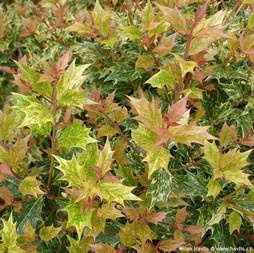 Osmanthus or Outerflower is a genus that is also not well known here. It was only a few years ago that the variety 'Triolor' (Goshiki) started to appear in supermarkets without any description, and quite often the sellers knew nothing about it. I have also come across descriptions that it is a new holly ...
Osmanthus or Outerflower is a genus that is also not well known here. It was only a few years ago that the variety 'Triolor' (Goshiki) started to appear in supermarkets without any description, and quite often the sellers knew nothing about it. I have also come across descriptions that it is a new holly ...
Osmanthus heterophyllus 'Goshiki' (Tricolor)
So let's start with this handsome one . It belongs to the variegated species and is the hardiest of all these. The hardiness on the leaves without damage was -24°C, and at -27°C the leaves and upper branches froze, but it rebloomed in spring and healed again within a season. Its leaves are really reminiscent of holly with their serrated edges. But the colouring is quite unique - no holly can do that yet. It is a rather smaller and very compact evergreen shrub, very rewarding and even tolerates winter sun. You can also find it in the botanical garden in Troja.
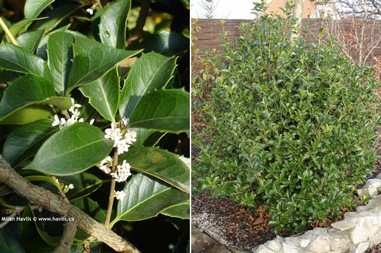 Osmanthus x fortunei (formerly o.aquifolium)
Osmanthus x fortunei (formerly o.aquifolium)
Here we are very close to holly, because this species is called Fortuna's Outerflower, and formerly even Outerflower spurge (as, for example, holly spurge). Again, this is an evergreen shrub with stiff leaves, larger than holly, which are not prickly but saw-toothed. They are dark green, slightly glossy, and the shrub grows without much interference to its wonderful shape and density. Only when the ground is frozen for long periods of time in overly sunny locations can the sun slightly scorch its leaves on the sunny side. However, it soon covers them with new ones in spring, so it is a beauty again. It has already withstood -24°C without losing a single twig. On the other hand, I cut his antennae from time to time, because every now and then he sprouts a long summer growth that spoils the symmetry of the bush. So a flick and it's gone. A lovely alternative to holly.
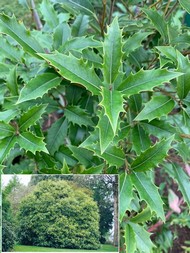 Osmanthus armatus
Osmanthus armatus
Sometimes there's a bit of fun in the garden world. Sometimes a lot of fun, or rather something that the English separate with the term ridiculous as opposed to funny. So a bit of fun is in the name of this outdoor flower - the armed outdoor flower. So that's a combination to me. By the way, I haven't yet said why an outflower. Well this shrub bears tiny white flowers in late summer and early fall. They're hidden inside the bush and smell absolutely lovely, a bit like orange blossom if you've ever smelled it. And armed? Because it has the most toothy leaves of any osmanthus, sharply serrated at the edges like the mouth of a sawfly, and whoever gave it that name probably thought it could defend itself with them. Certainly not against the vicious laloknosaurus.
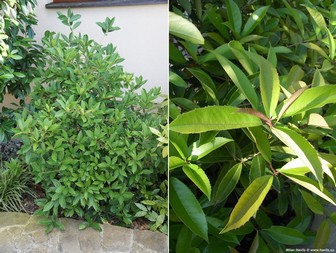 Osmanthus armatus versus Osmanthus fragrans
Osmanthus armatus versus Osmanthus fragrans
Well, here comes the funny part. I've had one shrub in my garden (550m above sea level) since 2006. Like all the others, we brought them from Italian nurseries under the name osmanthus armatus. And I trusted them because they were new plants to me then, information about the whole genus was scarce on the internet and there was nothing in our encyclopaedias. I suspected that its leaves were somehow finely serrated, but it didn't occur to me not to trust them. However, since I started to pay a lot of attention to outdoor flowers a few years ago, I didn't give up and searched and asked around. And this year (I am writing this at the end of 2019) I have come to the conclusion that my shrub, like many others like it, is not o.armatus, as the Tuscan nurseries believe, but osmanthus fragrans forma dentatus, in Czech oliva libovonná. This species is more variable in leaf shape and its sharpness, so it may have seemed to them more toothed and therefore more "armed". Instead of getting angry, I got a great joy, because I inadvertently managed to confirm that in our conditions it is possible to grow probably the most delicate species of the outdoor flower, which has large leaves without spines and probably the richest flowering.
It is true that after more than ten years of cultivation it has proved to be the most frost-sensitive of all those grown so far, but it has always survived. It doesn't so much mind our common frost in terms of the number of degrees below zero, but rather the duration of it. It can tolerate almost as many degrees below zero as osmanthus x fortunei, but it doesn't like to have its roots in frozen soil for too long. It survived the horrible winter of 2005/2007 (-27°C 3 nights in a row) perfectly well, only the upper part of the branches were burnt. And during the winter of 2009/2010, when the temperature did not drop below -21°C, but the ground was frozen for 3 months, it got a beating, even though it grows in absolute winter shade. All the leaves fell off in spring and he had to make new ones. Damage to the branches was minimal. This is due to both the prolonged frost (dehydration of the leaves) and the heavy, water-holding soil in which it grows.
It took a whole season to replace the foliage and it is clear to me that if I want to prevent this, I need to move it to better soil. But somehow I didn't get around to it ... and in the meantime it grew and grew into beauty. Today (2019) it's over 3 metres tall and I'm carving it into an attractive multi-trunk. To be completely honest, I should add that this is a selection of O. fragrans, which is not to say that every plant of this species will make it (and there are plenty of species and subspecies). But don't hang your head, in the meantime we have other plants in the "trial" to test for our winters. As soon as we have new information, we'll bring it back.
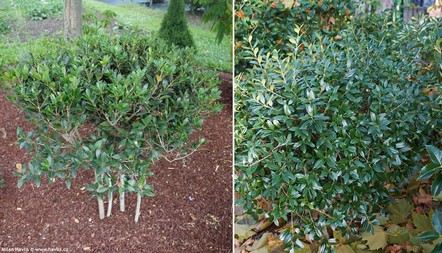 Osmanthus heterophyllus
Osmanthus heterophyllus
This addition to the outdoorflower family is my catch from about 2016. In Czech it's called Variegated Ovenflower and we've described its most difficult variety, Goshiki, above. I'm just more interested in the green leaves only and here I found them and then some. For until recently I had seen this beauty everywhere - young plants with small, sharply toothed leaves that looked more like a Mediterranean weed. Only once I was shown a larger specimen at an exhibition, as a grown tree on a low clover and with a thick crown, so it was obvious that it was already more years old and thus the typical feature of many spiny evergreens - the loss of spines later in life - became apparent. These little trees did not have a single visible toothed, let alone prickly, leaf. A few were hidden deep inside the crown, but who would look for them there, right? The leaves were like a caress. They were full, gracefully elliptical, dark green, very shiny and somehow nobly arranged along the branches, not at all like the common buxus, to which I think they are sometimes derogatorily compared. For me a definite gem, which I planted both in Prague and Chlumec and so far they have both experienced -21°C and have not even yawned. It grows beautifully in the green mass and grows close to my heart. We'll see how it goes, but it really turns out that the genus osmanthus has a lot up its sleeve for us :-)
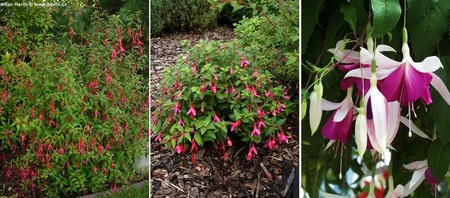 Hardy fuchsias
Hardy fuchsias
- Fuchsia magellanica 'Riccartonii' (on the left)
- Fuchsia 'Tom Tumb' (middle)
- Fuchsia magellanica 'Madame Cornelissen' (right)
Another major success in growing unusual plants was recorded after the winter of 2009/2010. As I mentioned above, this winter was not excessively cold but long. The plants had frozen roots for over 3 months. And perhaps this fact allowed the fuchsias, which we grew for the first time that year without winter cover, to overwinter without any problems. Several enthusiasts in the country have been growing these fuchsias outdoors for a couple of years now, and they always advise, as we do, to cover them with a pot, for example, before winter so that they don't get rained on or snowed in, as they hate the wet in winter. Thanks to the fact that there was a constant frost and the ground could not thaw, and therefore the roots were not waterlogged, we managed to preserve these fuchsias without any damage even without a cover, both in southern Bohemia and in Prague and its surroundings, where there was even more snow. The Riccartonii variety is vigorously growing, very abundant with spiky flowers, while the Tom Thumb variety is compact, forms a smaller clump and bears more showy flowers. The last species we are now trialling, which should have the same prospects of overwintering successfully, is named 'Madame Cornelissen' and bears white and red flowers. All the outdoor fuchsias are perennials in our house, and we cut the above-ground parts off after winter and let them re-grow. They flower profusely and continuously from early summer until the first cold days of autumn.
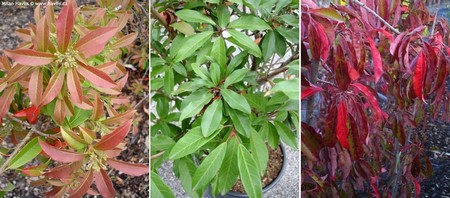 Stranvaesia davidiana = Photinia davidiana
Stranvaesia davidiana = Photinia davidiana
This plant has won me over with perhaps all its attributes. It is called David's Ivy and is an evergreen shrub that belongs to the same group as Red Robin, but is much more frost hardy. That it is a hardy plant was obvious even before I planted it in my garden, as I had plenty of information from similar locations around the world. We started selling it several years ago, although only a few specimens, mostly to enthusiastic curiosity collectors, until I was stopped by a customer who wanted it for the mountains of Sumava. That it would last in ordinary places in the country I knew, but in the mountains? That caught me off guard. She even wanted a large and rather expensive plant, so she had reason to be sure it would be fine there. The reason was simple - she already had one, but some animal had nibbled the plant at the end of winter. That's when I decided to plant it in a few different places, including my own garden, to learn more about the plant. Well, as it happens, there was a lot of work over the spring and summer, the season was slowly coming to an end and I only managed to plant one, while the others remained sort of forgotten outside, in thin plastic containers, on the sales floor over the winter. While the sakura and other normally hardy plants in containers froze (or rather withered) that winter, for example, all these bluebells in containers remained untouched by the frost and grew into even richer, beautiful shrubs in early spring. That was the reason I fell in love with David's Iris and we now offer it as a hardier option to Red Robin. Its leaves are narrower, looking like a large pieris, the new shoots are reddish-brown to dark burgundy, then turn a pleasant green, and in autumn they begin to show striking, distinctive red dots that spread across the leaves, so that the old leaves turn completely red and stay a bright ruby burgundy until spring.
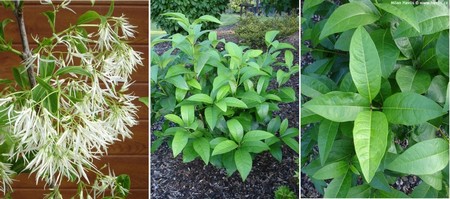 Chionanthus virginicus
Chionanthus virginicus
The whites are one of the most frequent topics of inquiries from you, our customers = collectors. It seems that despite all the assurances about its hardiness and the information available on other gardening websites around the world, you are still not sure whether such a beautiful oddity can live in our conditions. I myself have had it in my garden since 2006 and I must confirm that it gives me great pleasure. It grows reasonably fast, rather thickly and keeps a very nice shape. It flowered profusely every year until 2010. As I have mentioned many times, my garden does not have good soil conditions and some plants do not cope well, especially in winter. My whites were planted in an old part of the garden with hard ground that is waterlogged in the rains and parched in the dry. After the winter of 2009/2010, which was long and dry, some of the branches dried out, so I didn't wait for flowering and cut the bush back. If I had only trimmed the dead branches it would have lost its shape, so I pruned it radically. And the bush responded fantastically. It produced many new, strong and quite long shoots, so that it almost made up for its previous height, but it also offered something amazing: extra large leaves. My heavy pruning had a pollarding effect on it, and instead of flowering, the sapwood put all its strength into the leaves, so that it grew enormously spectacular, large, deep green, shiny and healthy leaves, which were admired by garden visitors from afar. I think this can be done even if you don't want to lose the flowers - cut it back severely immediately after flowering in June. The whites are definitely worth the extra bit of work.
That's all for now, but you can look forward to more posts - we've got the story of the Chinese bamboo oak (quercus myrsinifolia) or perhaps the broad-leaved yam (phillyrea latifolia) and its relatives. See you after further tests!












